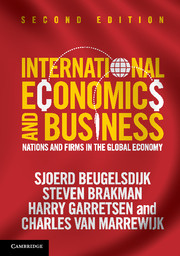Book contents
1 - The global economy
from Part I - Introduction
Summary
Keywords
Population • Distribution of population • Globalization • History of globalization • GDP in history • GDP and GNP • Global market integration • Migration • Barriers to trade • GDP per capita • Capital flows
Introduction
Numerous factors active in the global economic environment affect the decisions that managers of firms have to make regarding the price to charge for their products, how much to produce, how much to invest in R&D, how much to spend on advertising and so on. Some of these factors are the number of firms competing in a market, the relative size of firms, technological and cost considerations, demand conditions, and the ease with which competing foreign firms can enter or exit the market. The economic globalization process – that is, the increased interdependence of national economies, and the trend towards greater integration of goods, labour, and capital markets (see Section 1.4) – influences all these factors, and thus indirectly affects managerial decisions and market organization.
International economics analyses the interactions in the global economic environment. International business analyses the managerial decisions taken on the basis of a cost–benefit analysis in this global economic environment. In view of the above, we argue that central topics in international finance, business, and public policy cannot be understood without knowledge of international economics. Similarly, we conclude that the central topics in international economics cannot be fully understood without insights from international business.
- Type
- Chapter
- Information
- International Economics and BusinessNations and Firms in the Global Economy, pp. 3 - 37Publisher: Cambridge University PressPrint publication year: 2013

